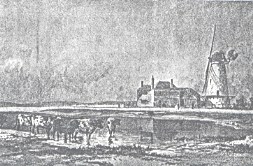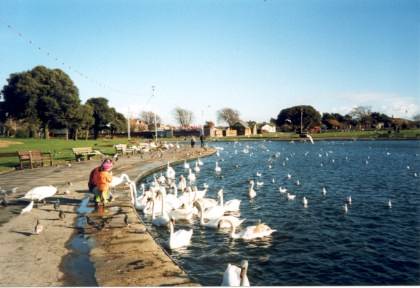CANOE LAKE, SOUTHSEAUp to the end of the 19th Century Southsea Common, including what is now Canoe Lake, was an extensive area of wetland called The Great Morass. Historical documents indicate that it was an important resort for a variety of wildfowl and, of course, their hunters, though I have no details of species or numbers. This history lives on currently in the name of the local district of Craneswater. In 1884 Portsmouth Corporation set about draining the Great Morass making it habitable and work on creating the new Canoe Lake was completed in June 1886. Here is an old photo of area as it was in 1860.
Nowadays, Canoe Lake is surrounded by a concrete path, with few, if any, natural features. It is a popular area for holidaymakers and their children who sail model boats and enjoy the rowing and pedal boats in the summer. There is a small cafe on the eastern side and a children's playground. In winter one of the most popular activities is feeding the swans.
BIRDS OF CANOE LAKEEarly in the century swans were encouraged on the new Canoe Lake by the presence of a Swannery and probably have been there ever since. Other birds regularly seen on the lake in winter are Mallard (though suprisingly few) and Tufted Duck, with occasional visits from Little Grebe, Cormorant, Pochard and Coot. Pied Wagtails are common around the lake and, of course, the ever present Feral Pigeons.
The lake is a very good site to look practice gull identification skills, since in winter gulls perch on the pleasure boats moored in the centre of the lake. Black-headed Gulls are the dominant species in winter, but I have recorded all the other common species in varying degrees of plumage, including Common, Herring, Lesser Black-backed, Greater Black-backed and Mediterranean. Until Oct 2000 the lake was regularly visited by a Dutch-ringed Med Gull marked O2K on its left leg. It was regularly recorded on Canoe Lake each year from 1995 until 2000, but not since then to my knowledge. The gull was ringed in Holland in 1994.
However, my main interest was in Mute Swan counts from 1996 to 2005.
MUTE SWAN COUNTS ON CANOE LAKEMute Swan counts have been recorded on Canoe Lake since at least 1980. The following chart shows the yearly peak counts from data taken from the Hampshire Bird Reports for 1980-1990 and from my own monthly counts from 1996 to 2005. The counts show a sharp increase from 1999 to 2001 followed by a gradual decline to 2004 and then by a dramatic fall to 2005. Something happened after 2003, I am not sure what, that drove the swans away, though I am aware that the Council did discourage residents from feeding the swans from that year.
The general monthly pattern over the years I counted showed a winter peak followed by a gradual decline to a summer trough when the lake was extensively used for recreational purposes.
WEDNESDAY MARCH 5 - 2014I was very surprised to find 23 Mute Swans on the water and around the edges.
During my counts, I used to get 40-80 swans until 2003 when they all disappeared. I never found out why, though I know the local council were discouraging people from feeding the birds to avoid pollution of the water. I have often had a quick look in the years since then, but have never seen anywhere near the number that were there today. Maybe, some of the evicted Emsworth Millpond swans were among them? There were many Black-headed Gulls and a few immature Herring Gulls on the pleasure boats in the centre of the lake, but no Mediterranean Gulls like I used to see here.




